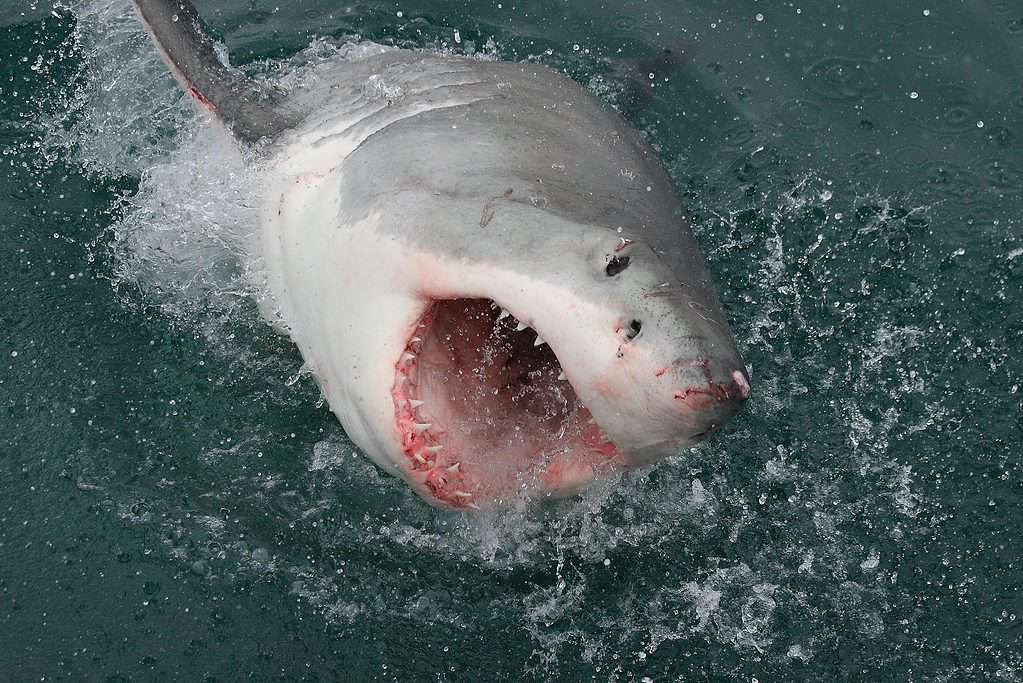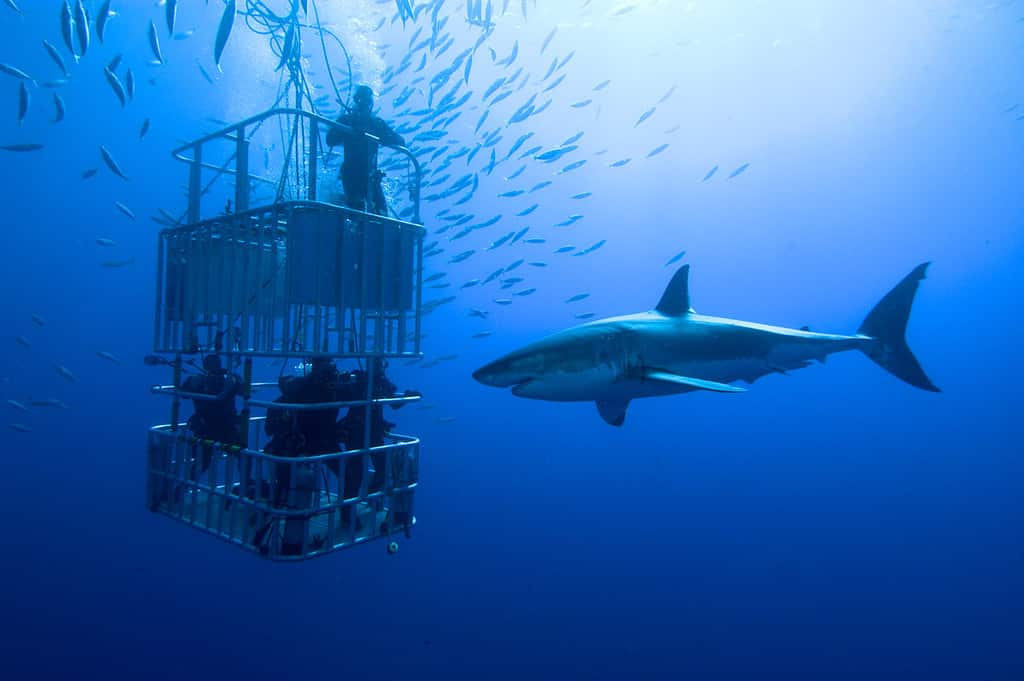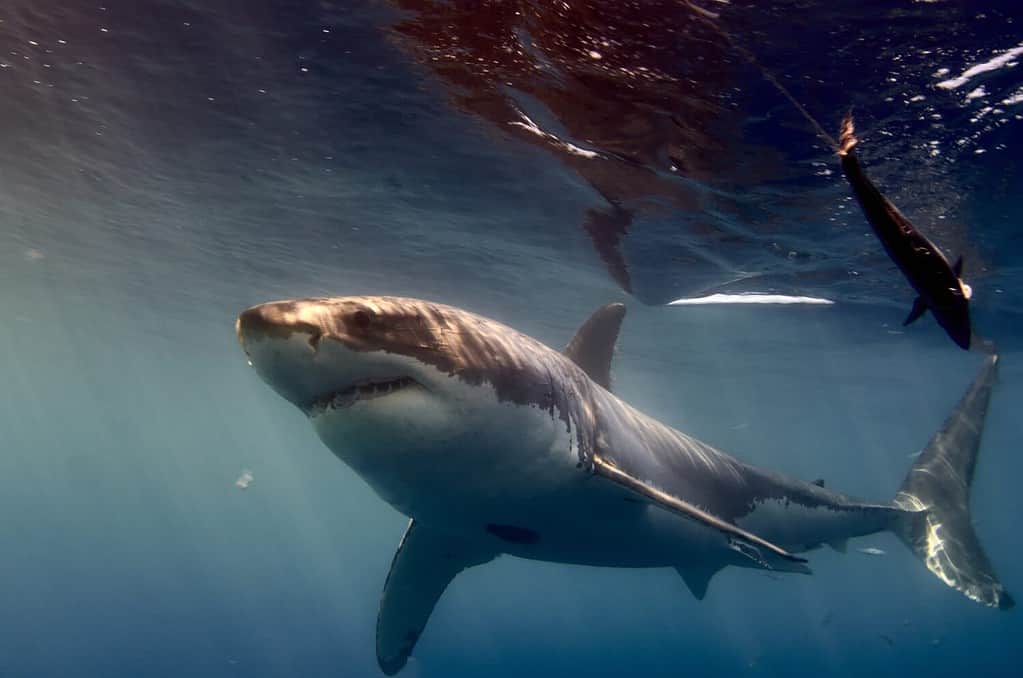Some people call them great whites and sometimes they call them white pointers. They’re massive, they’re curious, and sometimes they mistake humans for their favorite meals: seals. In the video below, you can watch incredible footage of a one-of-a-kind great white shark encounter!
Watch the Nail-Biting Footage Below!
Where Do Great White Sharks Live?

Great white sharks generally live in cool or temperate ocean waters near the coast.
©Alessandro De Maddalena/Shutterstock.com
You can find great white sharks throughout different oceans in the world.
There are two places where great white sharks don’t live, and they include the southern oceans and the Arctic. However, for the most densely populated areas, you can consider the United States, Japan, South Africa, Chile, and Oceania. Sometimes, they’re also found in the Mediterranean Sea.
In the U.S., great whites are found all the way up in Maine’s oceans and down to the Gulf of Mexico. On the west side of the U.S., you can find them in the Pacific Ocean, along California, and up to Alaska.
What is the Purpose of Shark Cage Diving?

©Martin Prochazkacz/Shutterstock.com
Shark cage diving is done for a variety of reasons. Sometimes, it could be something as simple as a tourist attraction.
Yes, some people want to dive into shark-infested waters and get a look at these underwater creatures up close! However, shark cage diving is also utilized for science. Within the confines and safety of a cage, researchers can observe these extra-large fish and learn more about them.
Those interested in underwater cinematography can also capture some amazing footage if they dare to enter a shark diving cage. Although some question the ethics of this practice, researchers see it as a net conservation benefit. It takes away the stigma of the shark when even tourists can get up close and know these creatures a little bit better.
Through these practices, there’s better awareness and hopefully, many walk away from the experience thinking of conservation efforts.
Diver’s Lucky Escape

It’s important to use every safety measure when getting near great white sharks.
©Willyam Bradberry/Shutterstock.com
In the video below, there are several men out on a boat in the middle of the ocean. Instead of the typical cages that you might see used with shark tourism, this one is completely clear with no bars — it’s a polycarbonate cage. They start lowering the cage into the water and their most fearless crew member, Jimmy, hops inside.
Jimmy is aware of the risks when he works with great white sharks but he’s confident from the moment he enters the cage. You get an aerial view that shows you this small, seemingly vulnerable cage in the middle of the ocean with nothing but water surrounding it.
In the next clip, you see Jimmy kneeling in the cage when a massive shark swims right under him. You have to watch the footage to see what happens when that shark attacks and breaks through the cage while Jimmy is in it!
Is it Normal For Great White Sharks to Attack Cages?

Sharks are intelligent and very curious animals and will often explore items by using their mouths.
©Stefan Pircher/Shutterstock.com
Sharks are often portrayed as ferocious predators, but the reality is that most shark attacks on humans are not intentional. The vast majority of shark attacks on humans are cases of mistaken identity. Humans are not part of their natural diet, which is comprised of numerous marine mammals and fish. Sharks are intelligent and very curious animals and will often explore items by using their mouths. The majority of shark attacks are due to curiosity or confusion, which unfortunately for the object of its curiosity, may result in death or destruction.
As curious animals, sharks will explore a cage in the water, and just like any many objects they run into, they will bite it to see if it is a food source. Once they realize that the cage is not only not edible, but not tasty, they will move on. As with any cage, whether metal or plexiglass, it is a foreign object to sharks and exploratory bumping or biting is normal.
How Large Are Adult Great Whites?

Spotted off the coast of Guadalupe Island, Mexico, Deep Blue is the largest great white on record.
©Wirestock Creators/Shutterstock.com
The largest great white shark can reach lengths of up to 20 feet, although the majority are smaller than this. Females are generally larger than males, with the average size of a female great white shark reaching between 15-16 feet, and the average size of a male reaching between 11-13 feet. Deep Blue is the largest great white on record, weighing in at an impressive estimated 2.5 tons and a length of over 20 feet.
The photo featured at the top of this post is © Vincent Legrand/Shutterstock.com
Thank you for reading! Have some feedback for us? Contact the AZ Animals editorial team.







